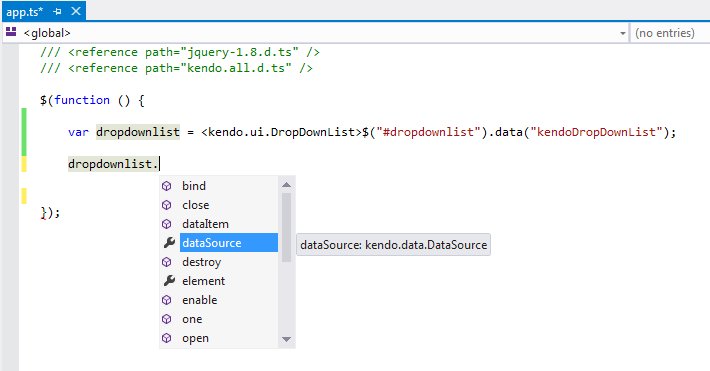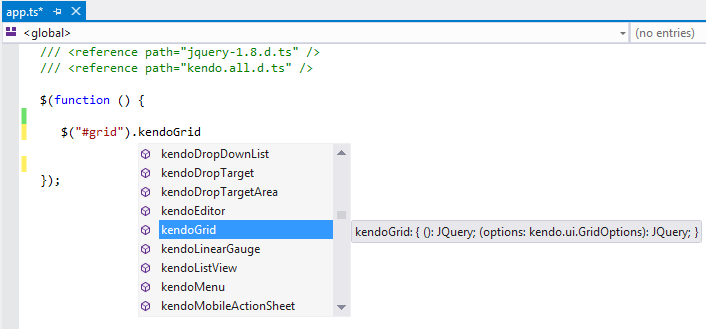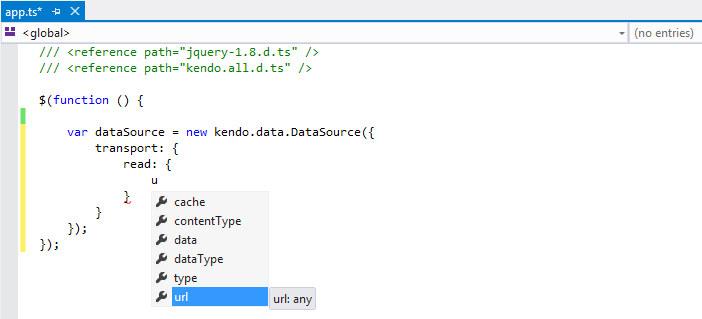TypeScript
Kendo UI provides a TypeScript definitions file which enables strongly-typed access to the Kendo UI widgets and their configuration.
Getting Started
You can install TypeScript either by using the redistributable package or NPM.
Using the Redistributable Package
Each Kendo UI distribution includes a typescript directory which contains a .d.ts file, i.e. kendo.all.d.ts. Copy this file to your project and in your TypeScript file add a reference to it as demonstrated below:
/// <reference path="kendo.all.d.ts" />You can optionally include the latest jQuery TypeScript definition file as well.
/// <reference path="jquery-1.8.d.ts" />
/// <reference path="kendo.all.d.ts" />Using NPM
Since the Kendo UI TypeScript definitions are available in the DefinitelyTyped project, they are also available as an npm package. To include them in your project, run the npm install --save @types/kendo-ui command.
Features
-
Getting instances of existing widgets

-
Initializing and configuring widgets

-
Initializing the Kendo UI DataSource

Creating widgets through TypeScript inheritance—The following example demonstrates how to inherit from an existing Kendo UI widget.
/// <reference path="jquery.d.ts" />
/// <reference path="kendo.all.d.ts" />
module KendoWidgets {
// (Optional) Extend the default widget options.
export interface MyDatePickerOptions extends kendo.ui.DatePickerOptions {
}
// Create a class which inherits from the Kendo UI widget.
export class MyDatePicker extends kendo.ui.DatePicker {
constructor(element: Element, options?: MyDatePickerOptions) {
super(element, options);
}
// (Optional) Override a widget method.
open() {
// Log to the console (optional).
console.log("open");
// Invoke a base widget method.
super.open();
}
}
// Create an alias of the prototype (required by kendo.ui.plugin).
MyDatePicker.fn = MyDatePicker.prototype;
// Deep clone the widget default options.
MyDatePicker.fn.options = $.extend(true, {}, kendo.ui.DatePicker.fn.options);
// Specify the name of your Kendo UI widget. Used to create the corresponding jQuery plugin.
MyDatePicker.fn.options.name = "MyDatePicker";
// Create a jQuery plugin.
kendo.ui.plugin(MyDatePicker);
}
// Expose the newly created jQuery plugin to TypeScript.
interface JQuery {
kendoMyDatePicker(options?: kendo.ui.DatePickerOptions): JQuery;
}
$(function () {
// Initialize your custom widget.
$("#datepicker").kendoMyDatePicker();
// Get a reference to the widget instance.
var myDatePicker = <KendoWidgets.MyDatePicker>$("#datepicker").data("kendoMyDatePicker");
// Call a widget method.
myDatePicker.open();
});- Using Kendo UI MVVM in TypeScript—When inheriting from
kendo.data.ObservableObjectin TypeScript you should call thesuper.initmethod to properly set up dependency tracking. The following example shows how to use Kendo UI MVVM in TypeScript.
/// <reference path="jquery.d.ts" />
/// <reference path="kendo.all.d.ts" />
class Person extends kendo.data.ObservableObject {
name = "John Doe";
constructor() {
super();
super.init(this);
}
}
class ViewModel extends kendo.data.ObservableObject {
person = new Person();
constructor() {
super();
super.init(this);
}
}
$(function () {
var viewModel = new ViewModel();
kendo.bind(document.body, viewModel);
viewModel.set("person.name", "Jane Doe");
});